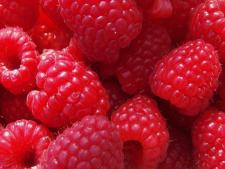-

raspberries
Supplied by
| Food | Percentage of DRI per 100 grams | |
|---|---|---|
| vitamin C | 35 | |
| manganese | 33 | |
| fiber | 26 | |
| copper | 10 | |
| vitamin K | 9 | |
| pantothenic acid | 7 | |
| biotin | 7 | |
| vitamin E | 6 | |
| magnesium | 6 | |
| omega-3 fats | 5 | |
| folate | 5 | |
| potassium | 4 | |
DESCRIPTION
Raspberries belong to the rose (Rosaceae) family of plants, together with almonds, apples, apricots, blackberries, cherries, loquats, peaches, pears, plums, and strawberries. Apart from the most common red (pink) raspberry there are also yellow, purple and black varieties. The purple variety came about by combining the red and black through naturally breeding (hybridizing). And over time the red raspberry went through a natural genetic mutation which resulted in the yellow-colored berry.
Raspberries have a remarkable diversity of anti-inflammatory antioxidants and phytonutrients. They are rich in vitamins C, A, E, K, and B-complex as well as minerals such as manganese, folate, potassium, iron, calcium, and magnesium.
The mineral-rich leaves of the raspberry plant have been used for thousands of years as herbal tea to boost fertility, soothe menstrual cramps, and prepare the womb for childbirth.
SELECTING
Raspberries are highly perishable so buy them just one or two days before you intend to use them. Unlike some fruits, once raspberries are picked, they stop ripening. So choose berries that are at their peak of color and ripeness, but still firm. This is also when the raspberry is at its peak of nutrition, fragrance and flavor. In the bottom of the package of fresh raspberries you’ll often find a thin paper pad. Check that it is still dry and clean. If the paper is wet with berry juice, that is a sign that the berries are over ripe.
Frozen raspberries are a good alternative when fresh are not available. They are harvested and flash-frozen at their peak and retain most of their nutritional properties. They are usually more economical too, so if you intend to use raspberries for smoothies, !ce creams or other blended treats, frozen ones are a convenient option.
Interestingly, when comparing cultivated organic raspberries with wild raspberries, they turn out to be quite similar, at least in terms of total phenols and anthocyanin content. Findings usually prove “wild” foods to be more nutrient dense, but this seems to not be the case when it comes to raspberries when it comes to phenols and anthocyanins.
HOW TO USE
Raspberries are a wonderful ingredient in shakes, !ce creams, fruit salads, jams, pies and so much more. They are the most nutritious when enjoyed fresh and unheated. Another thing to avoid is over-blending. Raspberries will oxidize when blended for a long time, and the result is a dull color and less nutrients. For a perfectly pink raspberry m!lk shake, add the berries at the very end and blend only for a few seconds.
Raspberries are very delicate and washing them can make them soggy and dull their flavor and fragrance. Some feel comfortable using them unwashed, especially if the source is known, they appear clean and are organic. Others insist raspberries should always be washed as they can harbor dirt, bugs, pesticides or bacteria. Avoid rinsing under running water as the pressure can be enough to squash the delicate berries. Instead, prepare a large bowl of cold water (adding a splash of vinegar to the bath can kill bacteria and potentially extend shelf life). Place the berries in the bath without overfilling, and swish them around for a few seconds. Then gently lift the berries into a colander and without shaking or tapping, just allow them to drain naturally before spreading onto a kitchen towel or paper towel to fully drain.
STORING
Because raspberries are highly perishable, extra care should be taken when it comes to their storage. Sort through the berries prior to storing, removing any over-ripe ones with signs of spoilage or mold. Place unwashed in a shallow breathable container lined with a paper towel and store in the refrigerator up to 2 days. Avoid leaving them out on the counter any longer than necessary before or after storing.
For longer storage, freezing is a great option. Spread the unwashed berries in a single layer on a tray lined with parchment paper and freeze for a few hours. Once they are frozen solid, transfer to a zip-lock bag or air-tight container and place back in the freezer.
SUBSTITUTIONS
If fresh raspberries are not available, frozen ones can be a good substitute.
Other berries can also be used instead of raspberries. Try strawberries, cherries, blueberries, blackberries or goji berries.
HEALTH BENEFITS
Raspberries have extraordinary amounts of phytonutrients with anti-aging and anti-inflammatory properties proven to significantly protect against atherosclerosis, arthritis, hypertension, type 2 diabetes, atherosclerosis and cancer.
One particular type of polyphenol in raspberries—ellagic acid—was found in studies to be especially important for removing toxins from the body and protecting against inflammation in the digestive tract, including Chron’s disease.
Naturally occurring compounds in raspberries called “raspberry ketones” have also captured the attention of researchers for their ability to increase metabolism in certain types of fat cells. This shows a decreased risk of obesity, regulation of blood fat balance and improved circulation.
Other health issues that raspberries can potentially help prevent include heart disease, chronic fatigue syndrome, fibromyalgia, lupus and scleroderma.
OXALATES
Raspberries contain measurable amounts of naturally-occurring antinutrients called oxalates. Once consumed, oxalates can bind onto minerals and crystalize in the colon or urinary tract. For most people these compounds are then eliminated through the stool or urine without any issues. However, an accumulation of oxalates in individuals with already existing and untreated kidney or gallbladder issues can be associated with an increased risk of kidney stones. Therefore, people who have had, or are at risk of developing kidney stones are often advised to minimize their consumption of high oxalate foods. Others claim oxalates are not the villain, and avoiding these vegetables and fruits is misguided, causing people to miss out on important antioxidants, fiber, vitamins, minerals and enzymes. Dr. Brooke Goldner, MD, among others, point out that it is a high intake of animal protein that leads to increased calcium and uric acid excretion as well as decreased urinary citrate – which is the most common cause of calcium oxalate kidney stones.
Further, some claim that oxalates may interfere with absorption of calcium which in turn can lead to mineral deficiency, leaky gut, malnutrition and even autism. Yet, every peer-reviewed research study shows, the ability of oxalates to lower calcium absorption is so small it does not outweigh the ability of oxalate-containing foods to contribute with calcium and other beneficial minerals.
HISTORY
Raspberries are thought to originate in Eastern Asia although researchers aren’t entirely sure. Different species of wild raspberries have been found native all over the world, including Europe, North America, Asia and Alaska. We also know through archaeological findings that Paleolithic cavemen consumed wild raspberries.
In terms of cultivation, raspberries were one of the earliest berry crops according to evidence dating back to the 4th century A.D. In ancient Greece, raspberries and raspberry leaves were used as a medicine, associated with fertility. In the middle ages it was common for artists to use the juice from the raspberries as tint for their works of art. By the 1500s the plant was cultivated all over Europe, said to have been spread by Trading, travelling and Roman solders. Colonial conquistadors' and explorers then brought the plant on their travels from Europe to North America.
Today, with a total of 400,000 tons harvested each year, raspberries are one of the most popular berries in the world. The main producer is Russia, followed by the United States, Mexico, Serbia and Poland.
REFERENCES
T. Colin Campbell, PhD and Thomas Campbell, MD. ‘The Plant Paradox’ by Steven Gundry MD– A Commentary. Published online August 23, 2017 — Updated January 3rd, 2019
Dr. Steven R Gundry, MD. The Plant Paradox: The Hidden Dangers in "Healthy" Foods That Cause Disease and Weight Gain. Harper Wave. 2017
Beekwilder J, Hall RD and de Vos CH. Identification and dietary relevance of antioxidants from raspberry. Biofactors. 2005;23(4):197-205. 2005.
Bobinaite R, Viskelis P and Venskutonis PR. Variation of total phenolics, anthocyanins, ellagic acid and radical scavenging capacity in various raspberry (Rubus spp.) cultivars. Food Chemistry, Volume 132, Issue 3, 1 June 2012, Pages 1495-1501.
Bowen-Forbes CS, Zhang Y and Nair MG. Anthocyanin content, antioxidant, anti-inflammatory and anticancer properties of blackberry and raspberry fruits. Journal of Food Composition and Analysis, Volume 23, Issue 6, September 2010, Pages 554-560.
Miromoto C, Satoh Y, Hara M et al. Anti-obese action of raspberry ketone. Life Sciences, Volume 77, Issue 2, 27 May 2005, Pages 194-204.
